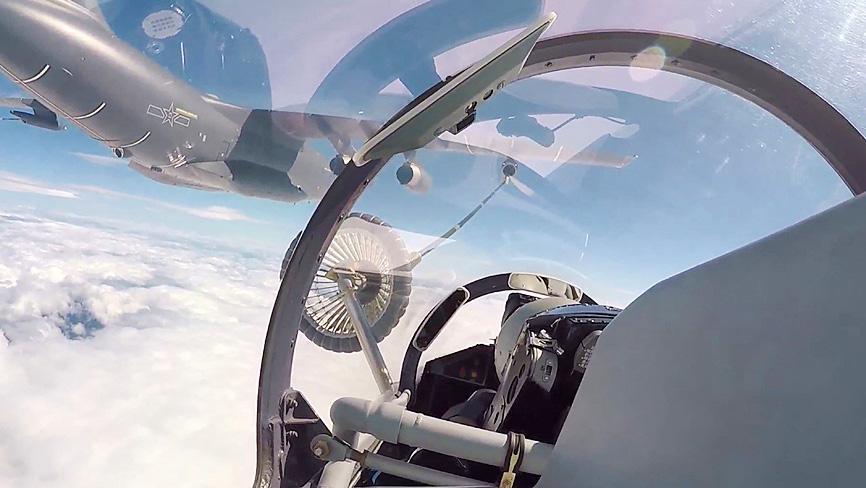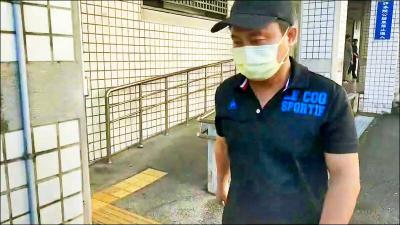While China’s expanded drills surrounding Taiwan have marked a military and political warning against “outside interference” over Taiwan, they opened a window to gather intelligence for the US and its allies.
The four days of intense drills from Aug. 4 to 7 — and extended maneuvers the following days — provide an opportunity to scrutinize the missiles China would use to drive off foreign militaries intervening in any invasion, as well as its command, control and communications systems, regional diplomats and security analysts say.
On the strategic intelligence front, the exercises have given a clue to China’s ability to blockade Taiwan as a prelude or alternative to any invasion, showcasing the firing of ballistic missiles over Taiwan for the first time, as well as simulated air and sea attacks on ships on its east coast.

Photo: AP
While acknowledging ongoing data gathering, two US military officials have said that the drills are unlikely to offer the type of in-depth intelligence opportunity provided by other maneuvers beyond the headlines.
China is unlikely to display its best tactics and strategies during drills that it knows are being watched closely, one of the officials said, speaking on condition of anonymity.
The officials said that most of the systems and missiles used by China appear to be known to the US and allies, so it was unclear how much more could be gleaned on their capabilities over the past few weeks.
Singapore-based security analyst Collin Koh (高瑞連) said rather than weaponry, the drills offered a prime chance to monitor key Chinese elements — the Chinese People’s Liberation Army’s (PLA) Eastern Theater Command, its Rocket Force and Strategic Support Force — operating together in a fully coordinated and integrated way.
“I fully expect the US to be collecting from a full spectrum — signals, communications and electronic intelligence — it is just a too good opportunity to miss,” he said.
“When you collect this kind of data from the other side, it means you can figure out where the vulnerabilities are, and it helps you create your own counter and jamming systems,” he said.
The US kept at least four warships east of Taiwan, centered around the USS Ronald Reagan aircraft carrier, during the exercises. While those ships wield a powerful strike threat, they also operate a vast surveillance capability above, across and under vast swathes of ocean.
Less visibly, Taiwanese, US and Japanese submarines and advanced surveillance aircraft are likely to be involved in the intelligence operation as well, analysts and retired intelligence officers say.
For example, submarines can collect a warship’s individual acoustic “signature” — vital data if a conflict is to ever break out.
Online trackers of aircraft and ships have also reported the presence of specialist electromagnetic intelligence gathering assets in the area, including powerful US RC-135S Cobra Ball aircraft and a missile monitoring ship.
Taiwan also launched its locally produced Albatross reconnaissance drones during the Chinese drills, according to video footage reviewed by Reuters.
The two US military officials said it would take time to analyze any intelligence harvested.
While the drills appeared to show that Beijing was able to coordinate its military forces from air, land and sea, the exercises could only reveal so much, as there was not an active adversary, they said.
“Things are easy when you’re not being shot at,” one of the officials said.
So far, the Pentagon has not changed its assessment that China would not be militarily capable of staging a successful invasion of Taiwan for five years.
The Pentagon’s No. 3 official on Monday last week said that despite Chinese exercises, the US had not changed its view that China was unlikely to try and militarily seize Taiwan in the next two years.
Trevor Hollingsbee, a former naval intelligence analyst at the British Ministry of Defence, said that a key signals intelligence target would be the role of political commissars on ships — an unusual system of Chinese Communist Party control compared with Western militaries.
“They will be looking for any evidence that the double-headed command system of employing a political officer on Chinese warships has a detrimental and exploitable effect upon combat efficiency,” he said.
A statement from the PLA’s Eastern Theater Command on Tuesday highlighted precautions.
It described early warning and jamming aircraft operating “under a complex electromagnetic environment to refine joint containment and control capabilities.”
However, on another level, China’s military chiefs might be unafraid of displaying their expertise in conducting such complex, integrated drills, some analysts believe.
“We got to observe and monitor a least a glimpse of how they look at doing that sort of thing,” said Carl Schuster, a Hawaii-based military analyst and a former director of operations at the US Pacific Command’s joint intelligence center.
“I think they wanted us to see it... I think they wanted us to know that this is not the PLA ... of even 10 years ago, they wanted us to know how far they had progressed,” he said.

South Korean K-pop girl group Blackpink are to make Kaohsiung the first stop on their Asia tour when they perform at Kaohsiung National Stadium on Oct. 18 and 19, the event organizer said yesterday. The upcoming performances will also make Blackpink the first girl group ever to perform twice at the stadium. It will be the group’s third visit to Taiwan to stage a concert. The last time Blackpink held a concert in the city was in March 2023. Their first concert in Taiwan was on March 3, 2019, at NTSU Arena (Linkou Arena). The group’s 2022-2023 “Born Pink” tour set a

CPBL players, cheerleaders and officials pose at a news conference in Taipei yesterday announcing the upcoming All-Star Game. This year’s CPBL All-Star Weekend is to be held at the Taipei Dome on July 19 and 20.

The Taiwan High Court yesterday upheld a lower court’s decision that ruled in favor of former president Tsai Ing-wen (蔡英文) regarding the legitimacy of her doctoral degree. The issue surrounding Tsai’s academic credentials was raised by former political talk show host Dennis Peng (彭文正) in a Facebook post in June 2019, when Tsai was seeking re-election. Peng has repeatedly accused Tsai of never completing her doctoral dissertation to get a doctoral degree in law from the London School of Economics and Political Science (LSE) in 1984. He subsequently filed a declaratory action charging that

The Hualien Branch of the High Court today sentenced the main suspect in the 2021 fatal derailment of the Taroko Express to 12 years and six months in jail in the second trial of the suspect for his role in Taiwan’s deadliest train crash. Lee Yi-hsiang (李義祥), the driver of a crane truck that fell onto the tracks and which the the Taiwan Railways Administration's (TRA) train crashed into in an accident that killed 49 people and injured 200, was sentenced to seven years and 10 months in the first trial by the Hualien District Court in 2022. Hoa Van Hao, a